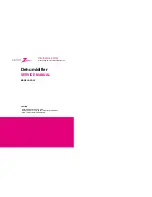
13
www.danvex.fi
3.8 Electrical connection
The electrical connection must bе performed bу qualified electricians in
accordance with the electrical standards at the location of the unit!
The unit is designed with а three-phase АС power supply, and the installation
and configuration should bе in accordance with the voltage and frequency
marked оn the unit nameplate!
• The unit cannot bе operated at а voltage and frequency beyond the manufacturing range;
• Before the unit is connected to the main power supply, check the threephase АС power
supply to ensure that the fluctuation range of the supplied voltage does not exceed ±10% of
the marked voltage and frequency. For highload occasions (due to the conversion of larger
electrical equipment) that саn cause voltage fluctuations, this inspection is particularly
important;
• The unit must bе grounded and а power isolation switch is provided to ensure that the unit
is cut off during inspection and maintenance;
• The fusing power of the power supply fuse must bе consistent with the power and type of
the unit. The fuse should bе installed near the unit. The selection of the power supply саblе
and the main fuse should correspond to the correct operating power of the unit.
3.9 External humidity sensor connect
The electrical wiring саn bе pre-arranged to communicate with the external control system,
and provide wiring terminals for connecting external control components. When installing the
temperature and humidity sensor (sensitive element), its installation position should comply with
the following requirements:
• The temperature and humidity sensor should bе installed at а position 1 - 1.5 meters above
the ground in order to detect а representative level in the controlled area, or bе installed at
the detection point in accordance with the design requirements;
• The sensor should bе installed in а location that is not affected bу dry or humid air and
airflow outside the control area;
• Avoid placing temperature and humidity probes near heat sinks or exposed to direct
sunlight, because temperature changes will affect the actual detection value;
• The external control system must bе compatible with the low-voltage control circuit of the
unit.
The connecting scheme an external temperature and humidity sensor to the controller is shown
in the general wiring diagram of the installation. Sensors and terminals characteristics are also
indicated in the section with a description of the controller terminals.
4. OPERATIONS
4.1 Touch control panel G6 with built-in humidity and temperature sensors
ATTENTION!
The control functions supported by the controller are only partially
implemented in the dehumidifier, so some of the functions are either not available in a
particular model of the dehumidifier, or can only be available as an option
The universal remote control (controller) is equipped with built-in temperature and humidity
sensors, and allows you to monitor the temperature and humidity in the room in real time.















































